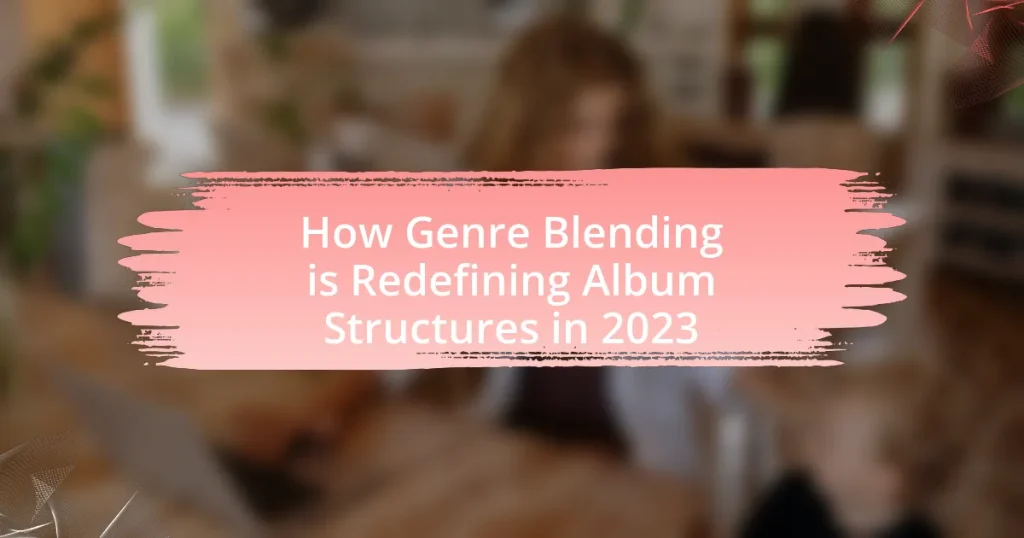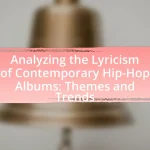Genre blending is significantly redefining album structures in 2023, allowing artists to create cohesive projects that transcend traditional genre boundaries. This trend is characterized by the seamless integration of diverse musical styles, resulting in innovative soundscapes and hybrid genres. Key artists such as Lil Nas X and Billie Eilish exemplify this movement by successfully merging elements from various genres, leading to richer storytelling and thematic depth in their albums. The rise of streaming platforms further supports this evolution, as listener preferences increasingly favor genre-defying tracks, prompting artists to experiment and innovate within their work. This article explores the characteristics, cultural influences, and implications of genre blending on album structures and the music industry as a whole.
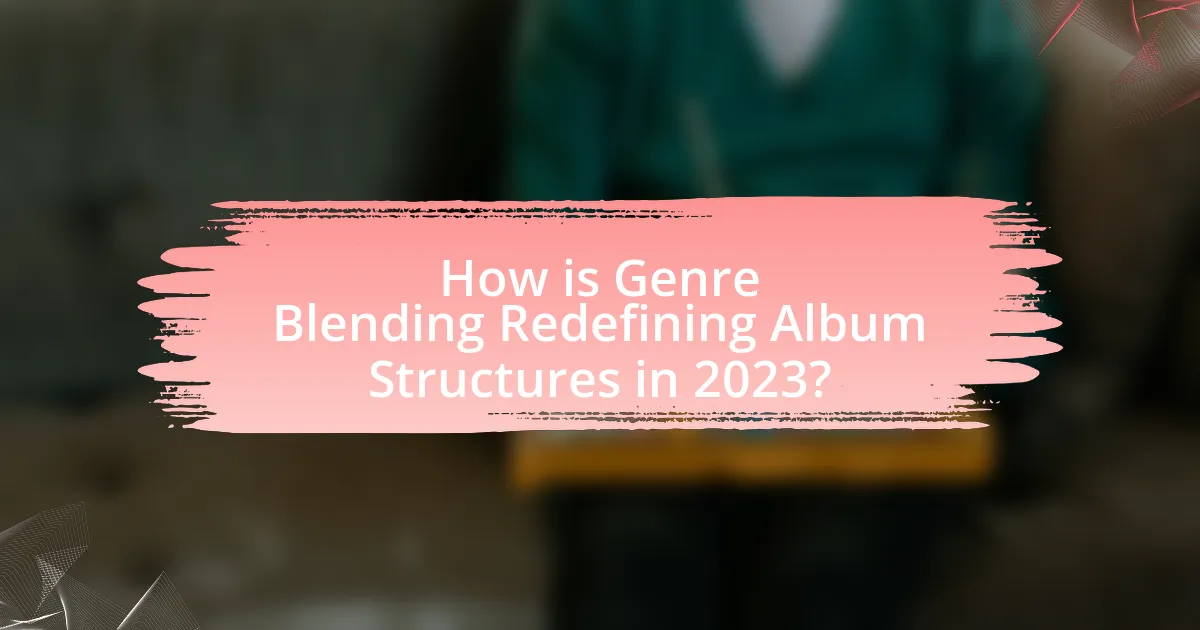
How is Genre Blending Redefining Album Structures in 2023?
Genre blending is redefining album structures in 2023 by encouraging artists to create cohesive projects that transcend traditional genre boundaries. This shift allows for more experimental sounds and diverse influences within a single album, resulting in a richer listening experience. For instance, artists like Lil Nas X and Billie Eilish have successfully integrated elements from pop, hip-hop, and electronic music, showcasing how genre fusion can lead to innovative storytelling and thematic depth. The rise of streaming platforms further supports this trend, as algorithms promote varied musical styles, enabling listeners to discover and appreciate genre-blended works.
What are the key characteristics of genre blending in music today?
Genre blending in music today is characterized by the seamless integration of diverse musical styles, resulting in innovative soundscapes that defy traditional genre boundaries. This phenomenon is evident in the rise of hybrid genres, such as country-rap and pop-punk, where artists combine elements from different genres to create unique auditory experiences. Additionally, the use of digital technology facilitates genre blending by allowing musicians to experiment with various sounds and production techniques, leading to more eclectic and diverse musical outputs. The popularity of streaming platforms further supports this trend, as listeners increasingly seek out genre-defying tracks, contributing to the mainstream acceptance of blended genres.
How does genre blending differ from traditional genre classifications?
Genre blending combines elements from multiple genres, creating a hybrid form that defies strict categorization, while traditional genre classifications rely on distinct, predefined categories with specific characteristics. Traditional classifications often limit artistic expression by enforcing rigid boundaries, whereas genre blending encourages innovation and experimentation, allowing artists to explore diverse influences and create unique soundscapes. For example, the rise of genres like country-rap illustrates how artists can merge styles to reach broader audiences, reflecting a shift in listener preferences towards more eclectic sounds. This evolution in music demonstrates that genre blending not only expands creative possibilities but also reshapes the music industry’s approach to categorization and marketing.
What role do artists play in the evolution of genre blending?
Artists are pivotal in the evolution of genre blending as they innovate by combining diverse musical styles to create new sounds. This blending often reflects cultural shifts and influences, allowing artists to reach broader audiences and challenge traditional genre boundaries. For instance, the rise of artists like Billie Eilish and Lil Nas X showcases how elements from pop, hip-hop, and electronic music can merge, leading to chart-topping hits that defy categorization. This trend is supported by data from the Recording Industry Association of America, which indicates a significant increase in genre-blending tracks on popular music charts over the past decade, highlighting the impact of artists in shaping contemporary music landscapes.
Why is genre blending becoming more prevalent in 2023?
Genre blending is becoming more prevalent in 2023 due to the increasing demand for innovative and diverse musical experiences among listeners. This shift is driven by the rise of digital platforms that allow artists to easily experiment with multiple genres, leading to a fusion of styles that appeals to a broader audience. Additionally, data from streaming services indicates that listeners are gravitating towards playlists that feature a mix of genres, reflecting a desire for variety and novelty in music consumption. As a result, artists are responding by creating works that defy traditional genre boundaries, further solidifying genre blending as a key trend in the music industry this year.
What cultural and technological factors are influencing genre blending?
Cultural and technological factors significantly influence genre blending by fostering cross-cultural collaborations and enabling innovative production techniques. The globalization of music has led to diverse influences, as artists from different backgrounds collaborate, creating hybrid sounds that merge various genres. For instance, the rise of streaming platforms allows listeners to access a wide array of musical styles, encouraging artists to experiment beyond traditional genre boundaries. Additionally, advancements in music production technology, such as digital audio workstations and software synthesizers, empower musicians to blend genres seamlessly, resulting in unique soundscapes. This combination of cultural exchange and technological innovation drives the evolution of music, leading to the emergence of new genres and redefining album structures in 2023.
How are listener preferences shaping the trend of genre blending?
Listener preferences are significantly shaping the trend of genre blending by driving artists to experiment with diverse musical styles to meet the evolving tastes of their audience. As streaming platforms provide listeners with access to a wide array of genres, data indicates that consumers increasingly favor tracks that incorporate elements from multiple genres, leading to a rise in hybrid musical forms. For instance, a report from the International Federation of the Phonographic Industry (IFPI) in 2022 highlighted that 70% of listeners enjoy music that blends different genres, demonstrating a clear demand for innovative sounds. This preference encourages artists to merge genres like hip-hop with rock or country with electronic, resulting in a more dynamic and varied listening experience that reflects the diverse interests of contemporary audiences.
What impact does genre blending have on album structures?
Genre blending significantly alters album structures by encouraging diverse musical elements and varied song formats within a single project. This approach allows artists to experiment with different styles, leading to a more dynamic listening experience that can include shifts in tempo, instrumentation, and lyrical themes. For instance, albums like “Blonde” by Frank Ocean and “Awaken, My Love!” by Childish Gambino showcase how blending genres such as R&B, hip-hop, and funk can create cohesive yet eclectic narratives, reflecting the artist’s versatility and broadening audience appeal. This trend has been supported by the rise of streaming platforms, which facilitate the discovery of varied genres, prompting artists to innovate their album structures to maintain listener engagement.
How are artists structuring albums to accommodate multiple genres?
Artists are structuring albums to accommodate multiple genres by creating cohesive narratives that blend diverse musical styles within a single project. This approach often involves strategic track sequencing, where songs transition smoothly between genres, allowing for a seamless listening experience. For instance, artists like Lil Nas X and Billie Eilish have successfully integrated elements of pop, hip-hop, and country, showcasing versatility while maintaining thematic consistency. Additionally, the use of interludes and skits can further enhance the narrative flow, providing context and depth to the genre shifts. This trend reflects a broader industry shift towards genre fluidity, as evidenced by the rise of genre-blending playlists on streaming platforms, which cater to diverse listener preferences and encourage artists to experiment beyond traditional genre boundaries.
What are the benefits of genre blending for album storytelling?
Genre blending enhances album storytelling by allowing artists to create more dynamic and multifaceted narratives. This approach enables musicians to draw from diverse emotional palettes and thematic elements, enriching the listener’s experience. For instance, combining elements of hip-hop with classical music can evoke contrasting feelings, thereby deepening the narrative complexity. Additionally, genre blending can attract a wider audience, as it appeals to fans of multiple genres, increasing engagement and reach. This trend is evident in albums like “24K Magic” by Bruno Mars, which incorporates funk, R&B, and pop, showcasing how varied musical influences can effectively convey a cohesive story.
How does genre blending affect the music industry?
Genre blending significantly impacts the music industry by fostering innovation and expanding audience reach. This phenomenon allows artists to combine elements from different genres, resulting in unique sounds that attract diverse listener demographics. For instance, the rise of genres like country-rap and pop-punk has led to increased chart success and streaming numbers, as evidenced by Lil Nas X’s “Old Town Road,” which topped the Billboard Hot 100 for 19 weeks in 2019, demonstrating the commercial viability of genre fusion. Additionally, genre blending encourages collaboration among artists from various backgrounds, further enriching the musical landscape and driving the evolution of album structures in 2023.
What challenges do record labels face with genre-blended albums?
Record labels face significant challenges with genre-blended albums, primarily due to marketing difficulties and audience segmentation. The blending of genres complicates the identification of a target demographic, making it harder for labels to effectively promote the album to specific listener groups. For instance, an album that combines hip-hop and country may alienate traditional fans of both genres, leading to reduced sales and streaming numbers. Additionally, genre-blended albums often struggle to fit into established playlists and radio formats, which are typically organized by distinct genres, further hindering exposure and reach. This challenge is underscored by data showing that genre-specific playlists dominate streaming platforms, limiting the visibility of hybrid works.
How are streaming platforms adapting to genre-blended music?
Streaming platforms are adapting to genre-blended music by enhancing their algorithms to better categorize and recommend tracks that combine multiple genres. For instance, platforms like Spotify and Apple Music utilize machine learning to analyze listening patterns and create playlists that reflect the diverse tastes of users, accommodating the rise of genre-blending artists. This adaptation is evidenced by the increasing popularity of curated playlists that feature hybrid genres, such as “Lo-fi Hip Hop” or “Indie Pop,” which have seen significant listener engagement, indicating a shift in consumer preferences towards more eclectic sounds.
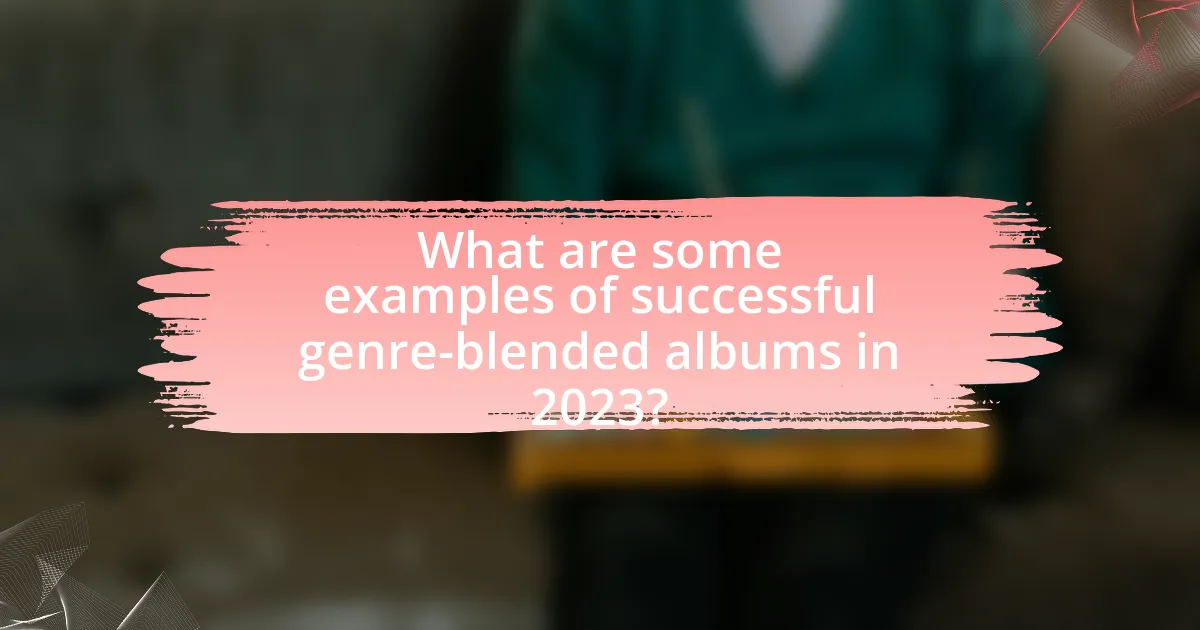
What are some examples of successful genre-blended albums in 2023?
Some examples of successful genre-blended albums in 2023 include “S.O.S” by SZA, which combines R&B, hip-hop, and pop elements, and “Renaissance” by Beyoncé, blending house, disco, and R&B. Both albums have received critical acclaim and commercial success, with “S.O.S” debuting at number one on the Billboard 200 and “Renaissance” earning multiple Grammy nominations, showcasing the effectiveness of genre blending in contemporary music.
Which artists are leading the genre-blending movement this year?
This year, artists such as Bad Bunny, Lil Nas X, and Billie Eilish are leading the genre-blending movement. Bad Bunny has successfully merged reggaeton with pop and rock elements, exemplified in his album “Un Verano Sin Ti,” which topped charts globally. Lil Nas X continues to redefine genre boundaries by blending country, rap, and pop in his music, notably with his hit “Montero (Call Me By Your Name).” Billie Eilish incorporates various genres, including pop, electronic, and alternative, in her album “Happier Than Ever,” showcasing her versatility and innovative sound. These artists exemplify how genre-blending is reshaping the music landscape in 2023.
What specific albums exemplify innovative genre blending?
“To Pimp a Butterfly” by Kendrick Lamar exemplifies innovative genre blending, merging hip-hop, jazz, funk, and spoken word. This album incorporates live instrumentation and complex lyrical themes, showcasing a fusion of styles that challenges traditional hip-hop norms. Another notable example is “Blonde” by Frank Ocean, which blends R&B, pop, and electronic music, creating a unique soundscape that defies genre classification. Additionally, “Awaken, My Love!” by Childish Gambino combines elements of funk, soul, and psychedelic rock, illustrating a departure from conventional hip-hop. These albums reflect the evolving landscape of music in 2023, where genre boundaries are increasingly blurred.
How have these albums been received by critics and audiences?
The albums have been received positively by both critics and audiences, often praised for their innovative approach to genre blending. Critics have highlighted the fresh sound and creativity, with many reviews noting that the albums push the boundaries of traditional music structures. For instance, several publications have awarded high ratings, reflecting a strong appreciation for the artistic risks taken. Audience reception has mirrored this enthusiasm, as evidenced by high streaming numbers and social media engagement, indicating a strong connection with listeners.
What lessons can emerging artists learn from genre-blended albums?
Emerging artists can learn the importance of versatility and innovation from genre-blended albums. These albums demonstrate that combining different musical styles can create unique sounds that resonate with diverse audiences, as seen in the success of artists like Lil Nas X, whose “Old Town Road” fused country and hip-hop, leading to widespread acclaim and chart-topping success. Additionally, genre-blending encourages artists to break traditional boundaries, allowing for greater creative expression and the ability to attract listeners from various musical backgrounds. This approach not only enhances artistic identity but also increases marketability in a competitive industry.
How can new artists effectively incorporate genre blending into their work?
New artists can effectively incorporate genre blending into their work by experimenting with diverse musical styles and influences to create unique soundscapes. This approach allows artists to reach broader audiences and differentiate themselves in a competitive market. For instance, artists like Lil Nas X have successfully blended country and hip-hop, resulting in chart-topping hits that appeal to fans of both genres. Additionally, research indicates that genre-blending can enhance listener engagement, as it introduces unexpected elements that keep the audience intrigued. By analyzing successful genre-blending artists and their techniques, new musicians can adopt similar strategies to innovate within their own music.
What strategies can artists use to market genre-blended albums?
Artists can market genre-blended albums by leveraging targeted social media campaigns, collaborating with influencers, and utilizing streaming platforms’ algorithmic playlists. Targeted social media campaigns allow artists to reach diverse audiences that appreciate multiple genres, increasing engagement and visibility. Collaborating with influencers who resonate with specific genres can amplify the album’s reach, as influencers often have dedicated followings that trust their recommendations. Additionally, utilizing streaming platforms’ algorithmic playlists can enhance discoverability; for instance, Spotify’s Discover Weekly and Release Radar playlists curate music based on user preferences, which can effectively introduce genre-blended albums to listeners who enjoy similar styles. These strategies are supported by data indicating that social media marketing can increase engagement rates by up to 120%, and playlists on streaming services account for over 30% of all music listening.
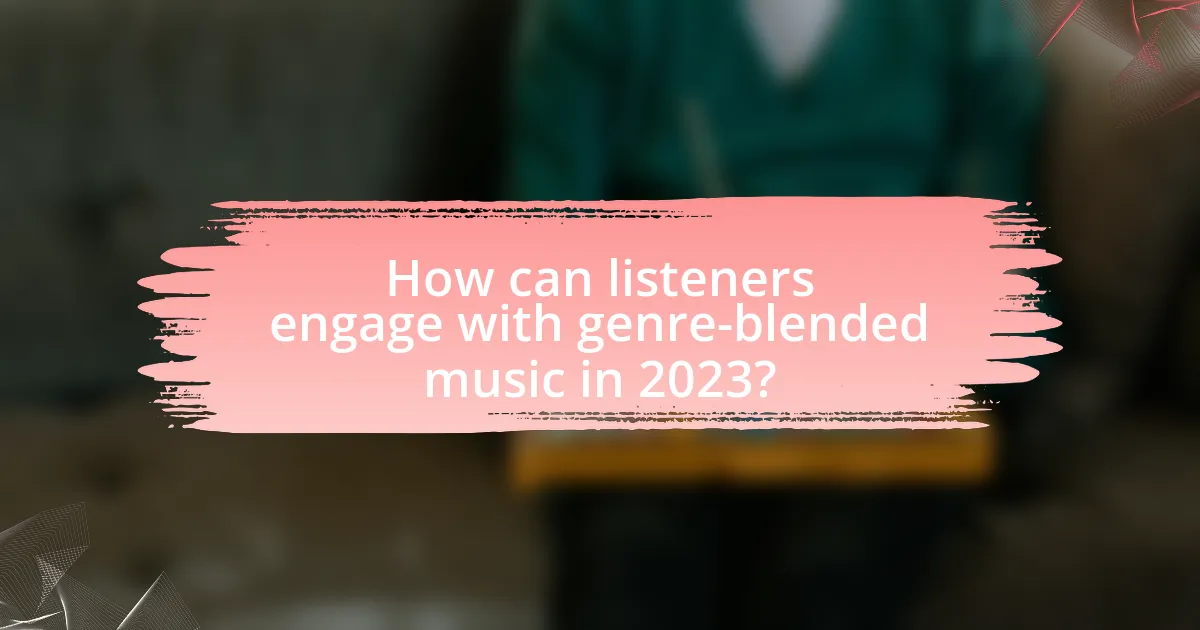
How can listeners engage with genre-blended music in 2023?
Listeners can engage with genre-blended music in 2023 by exploring diverse playlists on streaming platforms that curate tracks from various genres, allowing them to discover new sounds and artists. Streaming services like Spotify and Apple Music utilize algorithms to recommend genre-blended music based on user preferences, enhancing the listening experience. Additionally, attending live performances and festivals that feature genre-blending artists fosters a deeper connection to the music, as these events often showcase innovative collaborations and unique interpretations of different styles. Engaging with social media platforms where artists share their creative processes and influences also allows listeners to gain insights into the genre-blending phenomenon, further enriching their appreciation of the music.
What are the best ways to discover genre-blended albums?
The best ways to discover genre-blended albums include utilizing music streaming platforms, exploring curated playlists, and engaging with music communities. Music streaming platforms like Spotify and Apple Music offer algorithm-driven recommendations based on listening habits, which often highlight genre-blended albums. Curated playlists, such as those focused on specific themes or moods, frequently feature artists who blend genres, making them a valuable resource for discovery. Additionally, engaging with music communities on social media platforms and forums allows listeners to share and receive recommendations for genre-blended albums, fostering a collaborative exploration of diverse musical styles.
How can playlists enhance the experience of genre blending?
Playlists enhance the experience of genre blending by curating diverse musical selections that allow listeners to explore and appreciate the fusion of different styles. This curated approach enables seamless transitions between genres, facilitating a richer auditory experience. For instance, platforms like Spotify and Apple Music utilize algorithms to create playlists that mix genres, exposing listeners to unexpected combinations, which can lead to increased engagement and discovery of new artists. Research indicates that listeners are more likely to enjoy genre-blending music when presented in a playlist format, as it reduces the cognitive load of searching for compatible tracks and encourages exploration within a cohesive listening experience.
What role do music festivals play in promoting genre-blended artists?
Music festivals play a crucial role in promoting genre-blended artists by providing a platform for diverse musical expressions and attracting varied audiences. These events often feature a mix of genres, allowing genre-blended artists to showcase their unique sounds alongside traditional acts, thereby increasing their visibility. For instance, festivals like Coachella and Glastonbury have historically included artists who blend genres such as hip-hop, rock, and electronic music, which helps to validate and popularize these hybrid styles. This exposure can lead to increased streaming numbers, media coverage, and opportunities for collaboration, further solidifying the presence of genre-blended artists in the music industry.
What practical tips can enhance the listening experience of genre-blended albums?
To enhance the listening experience of genre-blended albums, listeners should actively engage with the music by using high-quality headphones or speakers, as superior audio equipment reveals the intricate layers and nuances of diverse genres. Additionally, creating a distraction-free environment allows for deeper focus on the album’s complexity, which is essential for appreciating the fusion of styles. Engaging with the album’s context, such as reading about the artists’ influences and the creative process, can also enrich understanding and enjoyment. Research indicates that active listening, where individuals pay close attention to the music rather than passively hearing it, significantly improves the overall experience, especially in genre-blended works that often contain unexpected transitions and elements.
How can listeners create their own genre-blended playlists?
Listeners can create their own genre-blended playlists by selecting tracks from multiple genres that complement each other. To achieve this, listeners should first identify genres they enjoy and explore sub-genres or related styles that may blend well, such as combining elements of jazz with hip-hop or rock with electronic music.
Utilizing music streaming platforms that offer genre-based recommendations can facilitate this process, as algorithms often suggest tracks that share similar characteristics. Additionally, listeners can pay attention to the tempo, mood, and instrumentation of songs to ensure a cohesive listening experience.
Research indicates that genre-blending enhances listener engagement, as diverse playlists can cater to varied musical tastes and create unique auditory experiences. This approach reflects the evolving landscape of music consumption in 2023, where genre boundaries are increasingly blurred.
What should listeners consider when exploring new genre-blended music?
Listeners should consider the unique characteristics and influences of each genre when exploring new genre-blended music. Understanding the foundational elements of the genres involved can enhance appreciation and provide context for the innovative combinations. For instance, genre-blended music often incorporates diverse rhythms, instrumentation, and lyrical themes, which can lead to a richer listening experience. Additionally, recognizing the cultural and historical backgrounds of the genres can deepen the listener’s connection to the music, as genre blending often reflects contemporary societal trends and artistic experimentation.
